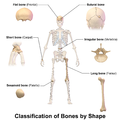Flat bone: Difference between revisions
CSV import |
CSV import |
||
| Line 32: | Line 32: | ||
{{stub}} | {{stub}} | ||
<gallery> | |||
File:Flat_bones_-_animation.gif|Flat bones animation | |||
File:Flat_bones_in_skull_-_lateral_view_-_with_legend.png|Flat bones in skull - lateral view with legend | |||
File:Blausen_0229_ClassificationofBones.png|Classification of bones | |||
</gallery> | |||
Latest revision as of 04:06, 18 February 2025
Flat bone
A flat bone is a type of bone that has a thin, flattened shape. Most flat bones serve as protection for the body's vital organs and provide a surface for muscle attachment. Examples of flat bones include the skull, the sternum, the scapula, and the pelvis.
Structure[edit]
Flat bones consist of two layers of compact bone surrounding a layer of spongy bone. This structure provides strength and protection while also allowing for flexibility. The outer layers of compact bone are dense and hard, providing a sturdy protective shell. The inner layer of spongy bone, also known as cancellous bone, is lighter and less dense, providing shock absorption.
Function[edit]
The primary function of flat bones is to protect the body's vital organs. For example, the skull protects the brain, the sternum and ribs protect the heart and lungs, and the pelvis protects the urinary and reproductive organs. In addition to protection, flat bones also serve as points of attachment for muscles, allowing for movement.
Development[edit]
Flat bones develop from connective tissue, in a process known as intramembranous ossification. This process begins in the fetus and continues into adolescence. During ossification, connective tissue is gradually replaced by bone, forming the flat shape characteristic of these bones.
Clinical significance[edit]
Flat bones are often involved in medical conditions and injuries. For example, fractures of the skull, sternum, or pelvis can be serious and require immediate medical attention. Conditions such as osteoporosis can also affect flat bones, leading to a decrease in bone density and an increased risk of fracture.





